Insightful newsletter of Drishtikone - Issue #89: 6 powerful life lessons from Near Death Experiences
What if I died today and was disembodied? Would that release from the body provide me with a perspective that is different? What will I encounter? These are questions that many have.
Some amongst us have had a strange experience - of Near-Death. The system stopped functioning - brain dead and/or cardiac dead. And despite the complete stoppage of awareness providing senses, something interesting happens to many such people. They know what happened, and they experience the “other world” and yet somehow for some strange reason come back. What do these people who come back say? On that journey, the stories are very similar - White loving and blissful light, feeling of meeting some “god” that your culture taught you about, meeting your dead relatives and “interaction” with the light, including a very interesting “life review”.
When we look at the greatest lessons from such experiences - we find six stand out. And, they all have no relationship to what the belief systems and religions hold above everything else.
And, “being a good human being” doesn’t help much. Here are the six lessons. For more detailed feedback and experiences, including the links to the sources, please check out our blogs - 6 powerful life lessons from Near-Death Experiences.
How much did you love? It is not about what deeds you did or did not do. Whether you thought they were good or bad. The Light “asks” about the engagement of love that you gave selflessly.
Life is a precious gift! This is most overwhelming for NDErs who committed suicide. One question that the lights “asks” is How was the precious gift of life used?
Include everyone as you. The “life review”, though non-judgmental, leaves one wondering and looking at every action that you undertook from the others’ standpoint. What if you were the other or had included the other within you? Would you still do that action?
Either Detached or Fully Engaged, but not attached to world. The aggressive NDErs become ‘laid back’ when they came back and the easy-going/lazy types come back with lots of energy. The action isn’t about what to get out of life, but what to give to it. Even when they became fully engaged with life, they lived with a certain detachment and playfulness.
Flowering of Humanity as opposed to “Code of conduct.” NDErs lose interest in ‘living by the code’ but become inclusive and trusting. Life becomes more about being all inclusive than following some moral code.
Knowledge of Self and Existence. Within the light, suddenly NDErs come in contact with all that is to know in the cosmos. They come back with increased wisdom and knowledge.
What if we were to imbibe these lessons without going through the experience of death ourselves?
“Trees fall with spectacular crashes. But planting is silent and growth is invisible.“ ― Richard Powers, The Overstory

when the 'fat man' devastated it all
August 9th was when the second atomic bomb was dropped on Nagasaki, Japan. The only two times that atomic bomb was dropped on a human population! 50,000 perished.
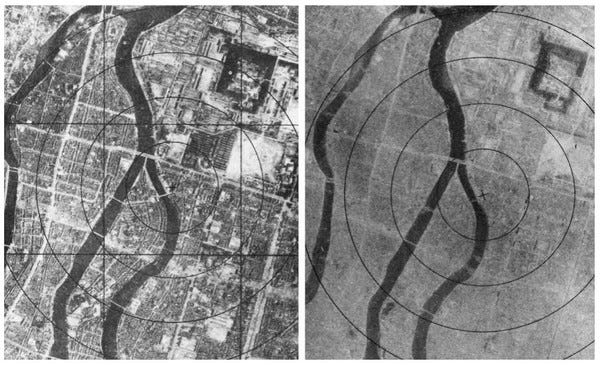
Aerial views of Hiroshima before (left) and after (right) the bombing (Public domain via Wikimedia Commons)
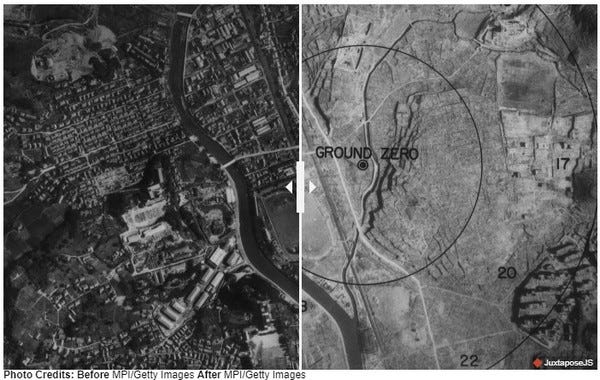
The first bomb was dropped on Hiroshima on Aug 6th, 1945. The American narrative says that because the bombing of Hiroshima failed to produce Japan’s immediate surrender, the Americans were “forced” to go ahead with the second atomic bomb on Nagasaki. Quite a virtuous lot the American leadership was even after unleashing the most deadly display of death in not one but two cities.
Maybe the Japanese military was brutal, but I don’t see it’s opponents being pacifists either. Its just who controlled the narrative post-war.
This documentary on the Nagasaki bombing, which normalizes the dastardly attack on Japan, has some interesting information. Please do watch it.

Atomic bombing of Nagasaki - BBC
why India is leading the global charge against China
Jeff Smith is the Research Fellow, South Asia-Heritage Foundation. He has authored Cold Peace: China-India Rivalry (2014) and Asia’s Quest for Balance (2018).
Personally, is one of the few analysts I follow on China.
He shared a series of tweets which I found very interesting. They show how India has become the world leader in dealing with China. No one has had either the guts or the imagination to take China on. And even defeat it in a battle.
Something that India did on that fateful night of June 14/15.
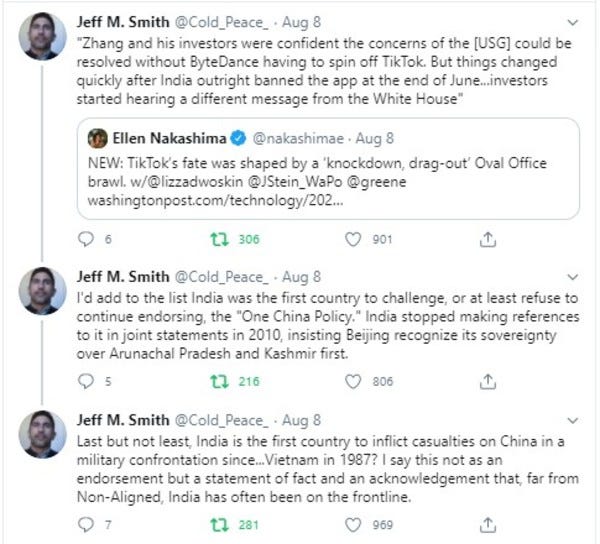
This is indeed a first. Such a reply back to the Chinese has not happened in the past by an Indian government.
one small move to choke route to South China Sea!
Meanwhile, Indian government is laying the foundation of connecting Andaman & Nicobar islands with mainland India. Remember we had discussed about how the Indian PM Modi had unfurled the Indian tricolor on December 30th, 2018?
Well, he was there for another thing. And, now you can see the completion of that project. A project that no one is talking about, but should!
Prime Minister Shri Narendra Modi will inaugurate and dedicate to the Nation through video conferencing the submarine Optical Fibre Cable (OFC) connecting Chennai and Port Blair on 10th August, 2020. The submarine cable will also connect Port Blair to Swaraj Dweep (Havelock), Little Andaman, Car Nicobar, Kamorta, Great Nicobar, Long Island, and Rangat. This connectivity will enable delivery of faster and more reliable mobile and landline telecom services to Andaman & Nicobar Islands, at par with other parts of India. The foundation stone for this project was laid by the Hon’ble Prime Minister on 30th December 2018 at Port Blair. (Source)
This one move, if combined with increased trade and military presence in Andamans, can change a lot of things geostrategically for India.
It can completely choke the maritime movement for the Chinese goods with India having a closer observation on the movement of ships entering South China Sea.
If India has a stronger presence in Andamans, then it is at the throat of the Strait of Malacca - the shortest route for Chinese goods to Asia, Africa and Europe!
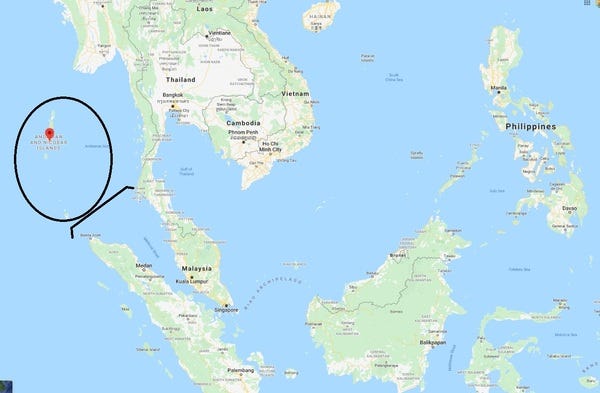
See the importance of this innocuous press release? (And, Modi’s visit to Port Blair in 2018?)
impact of mobile money and fintech expansion in India
IMF has done a study of the how mobile money use can impact economic outcomes in India. It is a very interesting study, which uses the data after the demonetization exercise was done and uses granular data on transactions from Paytm. It is one of the largest mobile money service provider in India with over 400 million users.
The results are astonishing as they are interesting. Two findings stand out:
A 10% increase in digi payments reduces risk of rain-triggered slowdown by 3%.
Firms using PayTM saw 26% hike in sales over 6 months vs non-PayTM firms.
The Real Effects of Mobile Money: Evidence from a Large-Scale Fintech Expansion
Mobile money services have rapidly expanded across emerging and developing economies and enabled new ways through which households and firms can conduct payments, save and send remittances.
Irrespective of what opinion one had about the demonetization, the impact on how the economy changed thereafter is humongous.
nota bene
Hot Spots residents developed COVID antibodies: In former Covid-19 hot spots of Mumbai, over 40% of residents have developed antibodies, data from a private lab has revealed. Of the 8,376 samples collected across the city between July 3 and August 7 by a private lab, 2,420 or 28.89% were detected with Covid-19 antibodies. A high ratio of the antibodies was developed among citizens from Govandi (57%), Dharavi (54%), Worli (42%), Chembur Extension (48%) and Mazagaon (40%) – all of which were earlier the city’s Covid-19 hotspots The prevalence of Covid-19 antibodies was relatively lower in certain areas of suburbs and south Mumbai, varying between 20-40%, data from Thyrocare Technologies Limited revealed. (Source)
DU Online open Book exams: Delhi University (DU) is all set to conduct online open-book exams for final-year students from Monday onwards. The differently-abled students, however, have said they will not be able to take the test and are accusing the university of being “exclusionary” and “discriminatory”. (Source)
Major remittances losses in Asia: The Asia Pacific, which accounts for a third of the global migrant workforce, is likely to face remittance losses of USD 31.4-54.3 billion due to the coronavirus pandemic, the Asian Development Bank (ADB) said in a report. The study is based on microdata from selected economies in South Asia and Southeast Asia. It suggests that a 10 percent increase in remittance inflows leads to a 3-4 percent rise in real GDP per capita. (Source)
Homeschooling grows in pandemic: In US, parents are resorting to new ways to educate their kids as crowded schools are opening up and pushing the incidences. DIY approaches to education—including homeschooling, learning pods, and microschools—are gaining popularity as public schools fold under pressure. (Source)
123- the happiest man
He is 123 years old. Swami Vivekananda was taking the West by storm when he was born. Swami Sivananda is a happy being. The passport authorities in India had verified his age from a temple register. He was just 6 when both his parents passed away on the same day and he was brought up by a man who introduced him to Yoga. A happy, content and simple being. Just watch this short movie on this amazing person!
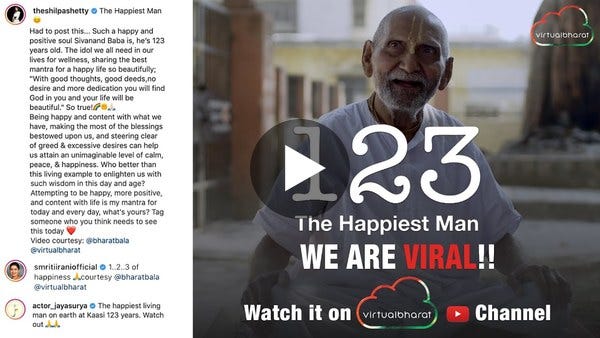
123 - The Happiest Man | Virtual Bharat
blast from the past
We share one past edition that you may have missed to go through and savor it again. In this edition we had listened to the singing of a beautiful poem by youngest ever Sahitya Akademi award winner in India’s history. We had looked in detail on how those who ruled and reported on Delhi betrayed the nation.
Insightful newsletter of Drishtikone - Issue #35: Civilizational Deserts
In democracies, governments are our representatives. What does one do when the government in a state starts to work with those who want to destroy the state and its institutions itself? When the agenda of those who govern includes spread of anarchy?


